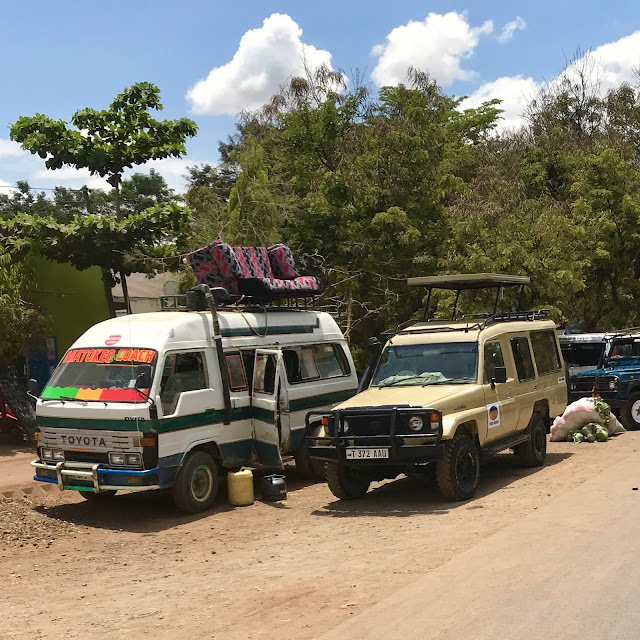A Dala Dala Ride to Remember
We keep moving forward, opening new doors, and doing new things, because we're curious
and curiosity keeps leading us down new paths. --Walt Disney
After a morning of serious learning and discovery, Lenny decided it was time for us to rub elbows with the locals. So for all of us who wanted to, he gave us each a shilling piece along with instructions to take a ride in a dala dala.
As described in Wikipedia, "Dala dala are minibus share taxis in Tanzania. Often overcrowded and operated at unsafe speeds, these minibuses developed as a response to an insufficient public transport system in the country."
Oh my! Had I read this description before my trip to Tanzania, I might not have taken Lenny up on his offer. But since I only read this as part of my post-trip research for this blog, I was game for a new experience. Clearly there is something to be said for 'ignorance is bliss' when traveling.
 |
| Lenny explains how to ride a dala dala |
Dala dalas get their name from the slang term for five Tanzanian shillings ("dala" for dollar), the bus fare in the 1970s and 1980s when these vehicles started operating.
Now a standard trip costs 400 shillings (25 cents), although the fare can be more if you're going a long distance.
Typically, dala dalas are bigger than a tuk tuk but smaller than a standard passenger bus. We saw them in sizes ranging from an extended 18-passenger van to mini bus size. Regardless, they are generally crammed with as many people as possible and then some with children seated on laps and people standing, albeit crouched.
All dala dalas are brightly painted with designs that apparently indicate the route along with seemingly random English words taken from the movies, TV, or pop-culture. I am not sure if they have meaning other than being 'hip,' but Lenny said the owner/drivers loved to one-up each other with the latest colorful signage.
 |
This dala dala even has room on the roof to carry a large sofa. Hopefully,
it's a purchase by a passenger, not extra seating for overflow passengers. |
The game plan was this: because there were nine of us, we divided into three-person teams; Lenny would tell each dala dala driver where we were to get off; and then we would exit the dala dala and wait for our tour bus to come along and pick us up. While on the dala dala, Lenny asked us to start a conversation with the people around us. That sounded easy enough, except I speak no Swahili, and I imagined most of the locals riding in a dala dala spoke little or no English.
The first dala dala stopped in front of us with only one person exiting and three of us wanting to get on. But having experience getting on the Paris Metro when full, I wasn't going to let a visibly packed dala dala scare me off. Clutching the coin in my hand, I squeezed myself on board, eyeing a potential empty seat in the back row. Doug followed me and sat on a jump seat in the row in front of me while a man, woman, and child entered and squeezed in between Doug and the left window. Our third traveler found a space toward the front as seen by the shock of blond hair visible at the shoulder of the standing woman. Then we were off.
The little boy appeared to be mesmerized by Doug. And I was mesmerized by his big, brown eyes. . .
. . . and his cute orange A-B-C cap.
As per Lenny's instructions, I tried talking to the people around me. To my left was a mother and daughter, both dressed in black burkas. The young girl's face was showing; however, I could only see her mother's eyes. While her daughter giggled with her hand covering her mouth, I couldn't tell what the mother was thinking as I tried in vain to explain my presence.
However, to my right sat a young man dressed in a dapper shirt, tie and jacket who did speak English. I found out that he was an Information Technology consultant on his way home from work. I spoke with him until I realized we had been on the dala dala for quite awhile and became concerned about when we were supposed to get off. A few stops later, our third traveler shouted back to us, "Now!" and we squeezed past the other riders and exited handing our shillings to the conductor.
Then we stood for what seemed like a very long time watching more dala dalas stopping to unload and take on new passengers, until eventually three more OAT travelers disembarked and then three more. Within minutes, our tour bus stopped and picked us all up.
Chalk up another exciting and successful learning and discovery adventure!
I especially liked this man with his color-coordinated yellow shirt with the yellow lemons he was selling. I asked if I could take his picture, and he willingly flashed me the peace sign.
Each dala dala is owned by the driver. The routes are regulated and fees are pre-set. Typically, dala dalas pick up passengers at central locations; however, they will also stop anywhere along their route to drop someone off or allow a prospective passenger to board
But the dala dala is not a one-man operation. In addition to the driver, there is a conductor called a mpigadebe. The conductor gets out at every stop and tries to convince passers-by that they want to ride the bus. He hits the roof of the bus when it's time to move on. And he collects the fare as each rider disembarks.